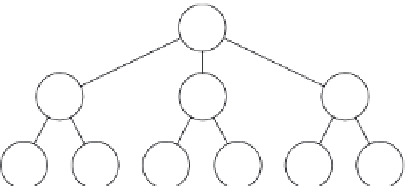Information Technology Reference
In-Depth Information
education environment and enhance their learning in the ubiquitous learn-
ing environment.
In general, a LBS can be defined as triggered and user requested. Triggered
LBS relies on a condition set up in advance that retrieves the position of a
given device (e.g., passes across the boundaries, emergency services). With
user-requested LBS, the user is retrieving the position once and uses it on
subsequent requests for location-dependent information. This LBS type
involves personal location (i.e., where you are) or services location (i.e., where
the nearest is) [6]. The location-based optimal grouping service falls into the
second category as the grouping service is offered on the basis of request.
The client agent has to be able to identify what location information is
available, to acquire the location information, and to send the location infor-
mation to a central server agent. It also has to collaborate with other agents
in the multi-agent environment.
Regarding the guidance message generator in this framework, the spatial
knowledge is an important research issue. Mohan and Kashyap have pro-
posed an object-oriented model for representing the spatial knowledge in
tree form [16]. All the objects in the real world can be represented in hierarchy
form as Figure 16.1 shows. There are two benefits of using object-oriented
representation to store the spatial knowledge: (1) it is easy to describe the
relations among objects and (2) the structure can be transformed to various
forms simply.
Del has discussed the spatial relationships in geometry and he has clas-
sified the relationships into directional relationships and topological rela-
tionships [8]. Directional relations include front, back, right, left, east, west,
south, and north. Egenhofer and Fransoza have proposed a nine-intersection
spatial model [9]. The nine-intersection model involves 29 topological rela-
tionships. The 29 topological relationships can be categorized into eight cate-
gories, including DISJOINT, MEET, INSIDE, EQUAL, CONTAINS, COVERS,
COVERED BY, and OVERLAP.
Beside the spatial knowledge structure and relations, the landmark research
is also necessary for developing the guidance message generator. There are
three basic elements to guide a person moving in the real world: orientation,
O
O
1
O
2
O
3
O
11
O
12
O
21
O
22
O
31
O
32
Figure 16.1
Spatial structure hierarchy.





